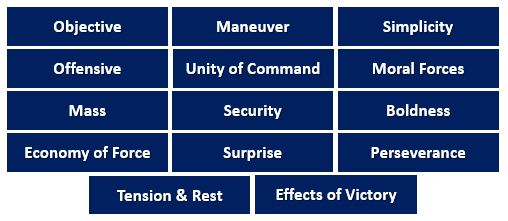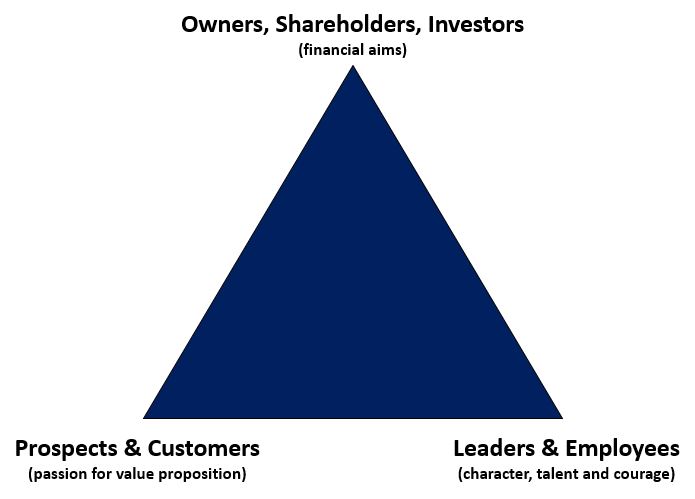What can business and sales leaders learn about marketing and sales strategy from a Prussian General from the 1800’s? Surprisingly, more than you think. Carl von Clausewitz was frustrated on the battlefield by the:
- Lack of clear direction and contradicting orders, especially when under pressure.
- Slow speed of strategic and operational decision making.
- Disconnect between the military, government, and civilians.
- Constant disruptions that were unrelated to the task at hand.
- And I’m confident, much, much more.
If you share any of these frustrations, then read on.
After every battle, Clausewitz documented his observations in search of a framework to solve these problems. In 1832, his observations were published in the seminal book On War. It became the most important book ever written on the theory of warfare and strategy.
Today business, government, and military leaders around the world use it to evaluate and focus their strategy.
So, what does any of this have to do with marketing and sales strategy? We found five concepts in On War that helped us evaluate and focus marketing and sales strategy:
- The relationship between offense and defense
- The principles of war
- Friction
- The center of gravity
- The paradoxical trinity of war
Let’s explore each to see what lessons we can learn.
Concept #1 – The Relationship Between Offense and Defense
Clausewitz states that “there are two forms of war, offense and defense. The party on the defensive has the advantage of ground; therefore, the defensive is a stronger form of war. But rest assured that the offensive will seek you out.”
Clausewitz also points out that “both offensive and defensive actions by nature can be either strategic or tactical.” He concludes that “your theory of war must concentrate on the form of war that your enemy is fighting. If they are fighting on tactical offense and you on strategic defense frustration and wasted resources will ensue.”
Sales Strategy Exercise #1
In business terms, offense is about capturing market share and defense is about building share of wallet. To better understand the impact of this concept on our marketing and sales strategy, we took three steps:
- We defined four quadrants in a matrix:
- Strategic offense = generating awareness and leads in new markets
- Tactical offense = acquiring new customers
- Tactical defense = renewing and up-selling existing customers
- Strategic defense = cross-selling existing customers
- Then we placed each of our objectives and goals into the quadrant that it was focused on.
- Finally, we allocated our resources (time, headcount, and budget) into the appropriate quadrant.
We found that our resources were spread out across the quadrants. We also found that our primary objective and goal was receiving the least amount of resources. No wonder our company was not achieving its revenue goals. So, we used the matrix to realign and focus our objectives, goals, initiatives, and resources.
Concept #2 – The Principles of War
While Sun Tzu documented the first known principles of war in 1521, Clausewitz brought them to life in On War in 1832. Clausewitz states that “there are certain principles that illuminate failure in conflict. Clarifying and controlling these principles increases the probability of gaining ground in battle.”
The US Army uses nine principles of war to ensure that its strategy is clear, decisive, and attainable including:
- Objective – every military (company) operation should be directed towards a clearly defined, decisive, and attainable objective. Clausewitz states that “we always have the choice between the most audacious and the most careful solution, but we must recognize that no military leader has ever become great without ”
- Offensive – seize, retain and exploit the initiative over the enemy (competitors).
- Mass – concentrate combat (company) power at the decisive place and time (niche).
- Economy of Force – allocate minimum essential combat (sales, marketing, and operations) power to secondary (support) efforts.
- Maneuver – place the enemy (competitors) in a position of disadvantage through the flexible application of combat (sales, marketing, and operations) power.
- Unity of Command – for every objective, there should be unity of effort under one responsible leader; multiple commanders (leaders) leads to wasted resources and disaster.
- Security – never permit the enemy (competitors) to acquire an unexpected advantage.
- Surprise – strike the enemy (competitors) at a time and/or place and in a manner for which they are unprepared.
- Simplicity – prepare clear, uncomplicated plans and clear, concise orders (responsibilities) to ensure thorough understanding.
Clausewitz references five additional principles that are relevant to marketing and sales strategy:
- Moral forces – match positive words to actions to animate the spirit of your forces
- Boldness – always guide passion and intensity with targeted purpose.
- Perseverance – expect the unexpected, adapt, and overcome
- Tension and rest – control the tempo and pace to sustain the battle
- Effects of Victory – continuously seek flaws and fix them
Sales Strategy Exercise #2
We used The Fourteen Principles of War as a strategy checklist. We reviewed each objective, goal, and initiative against the checklist. We found that our marketing and sales strategy was unclear, indecisive, and unattainable. We then used the strategy checklist to refine our objectives, goals, and initiatives to make them clear, decisive, and attainable.
Concept #3 – Friction
Clausewitz states that “everything is very simple in war, but the simplest thing is difficult. These difficulties accumulate and produce a friction, which no person can imagine exactly who has not seen war.” He goes on to state that “through the influence of an infinity of petty circumstances, which cannot properly be described on paper, things disappoint us, and we fall short of the mark. Friction is the only concept which, in a general way, corresponds to that which distinguishes real war from war on paper.”
He concludes that “activity in war is movement in a resistant environment. The knowledge and plans to address this friction is a chief part of the theory of war and what is required in a good general.”
Sales Strategy Exercise #3
We reviewed each objective, goal, and initiative in our marketing and sales strategy to:
- Anticipate the sources of friction and assign a probability or likelihood.
- Establish multiple scenario plans that can be quickly implemented when friction occurs.
- Install listening posts (measures, employee hotlines, customer research) to spot friction and trigger adjustments.
This exercise highlighted that our business leaders, sales leader, managers, and people were not on the same page. There was no alignment on the sources of friction and what to do about them. It’s worth noting that our salespeople were great listening posts for spotting friction. Unfortunately, we did not have a central clearinghouse for their communications. This exercise helped us fix that too.
Concept #4 – The Center of Gravity
Clausewitz found that to achieve success, military strategy must concentrate on one of four main objects of war:
- To conquer and destroy the armed power (value proposition) of the enemy (competitors); always direct our principal operation against the main body (competencies) of the enemy army or at least against an important portion of their forces.
- To take possession of (acquire or partner with) their material and other sources of strength, and to direct our operations against the places where most of these resources are concentrated.
- To gain public opinion (customers), won through great victories and the occupation of the enemy’s capital (primary market niche).
- To destroy relationships between your enemy (competitors) and the army of the country protecting them (investors, channel partners).
He states that “if you properly identify, attack, and destroy your enemies center of gravity you will defeat them. But you must understand your own center of gravity and defend it from your enemy.”
Sales Strategy Exercise #4
Through this lens, we realized that our marketing and sales strategy was focused inward on what we wanted to achieve. We reviewed each product and service, objective, goal, and initiatives to:
- Define what Center of Gravity they were focused on.
- Estimate what percentage of our sales and marketing employee headcount was focused on that center of gravity.
- Estimate what percentage of time marketing and sales leadership team was spending on that center of gravity.
We found that we were focused on our own unique differentiation compared to our competitors. To resolve this problem, we established a center of gravity for each competitor and allocated resources to attack it.
Concept #5 – The Paradoxical Trinity of War
Clausewitz uses this concept to highlight the need for a well-rounded and balanced strategy. He states that “the passions that are to be kindled in war must already be inherent in the people; the scope which the play of courage and talent will enjoy in the realm of probability and chance, depends on the particular character of the commander and the army; but the political aims are the business of government alone.”
He goes on to state that “these three tendencies are like three different codes of law, deep-rooted in their subject, and yet variable in their relationship to one another. A theory that ignores any one of them or seeks to fix an arbitrary relationship between them would conflict with reality to such an extent that for this reason alone it would be totally useless.”
Clausewitz concludes that “our task, therefore, is to develop a theory that maintains a balance between these three tendencies, like an object suspended between three magnets.”
Sales Strategy Exercise #5
We translated Clausewitz’s concept into The Paradoxical Trinity of Business. We then used this framework to evaluate and focus our marketing and sales strategy. We reviewed each product and service, objective, goal, and initiative to see if they maintained a balance between the:
- Passions that are to be kindled in your customers i.e. the people by your offerings and value propositions.
- Character, talent, and courage of your sales leader, managers, and people that enable your company to benefit from the realm of probability and chance.
- The financial aims of your owners, shareholders, and investors are driving your sales operations?
We found that our marketing and sales strategy was not balanced. Our objective, goals, and initiatives were heavily skewed to our customers. We were missing opportunities in the market because we were not leveraging the character, talent, and courage of our people. We also found that we had unintentionally demonized our investors because we didn’t understand their financial aims.
So, we used The Paradoxical Trinity of Business to bring greater balance and to communicate our strategy to sales managers and people.
Some Final Insights from Clausewitz
The following Clausewitz statements helped to frame our thinking about marketing and sales strategy:
- War (business) is never something autonomous. It is an act of policy (making money), a true political (financial) instrument, a continuation of political (financial) discourse carried on by other means. It is complex, ever-changing, and never final. It is shaped by the elements of genius, danger, physical exertion, information, and friction.
- We go to war to compel our enemy (competitors) to do our will.
- Savage people (customers) are ruled by emotion and passion, civilized people (customers) are ruled by the mind.
- The only situation that a commander (leader) can understand is their own; their opponents (competitors) situation can only be understood from unreliable (competitive and market) intelligence.
- Courage and self-confidence are essential in war (business); arrogance leads to the destruction of materials and human beings.
In Conclusion
If you or your team are frustrated by the:
- Lack of clear direction and contradicting orders, especially when under pressure.
- Slow speed of strategic and operational decision making.
- Disconnect between the company, customers, and investors.
- Constant disruptions that were unrelated to the task at hand.
- And other revenue growth challenges.
Then it’s a safe bet that your marketing and sales strategy is unclear, indecisive, and unattainable. Clausewitz offers five key concepts that can help solve this problem:
- The relationship between offense and defense
- The principles of war
- Friction
- The paradoxical trinity of war
- The center of gravity
Completing the six exercises above will shed light on where your products and services, objectives, goals, and initiatives are flawed. Fixing these flaws will make your marketing and sales strategy clear, decisive, and attainable.
A final thought from Clausewitz – – “there is no victory in strategy, only preparation for tactical victory.”
Please Take a Minute To:
- Write a comment on this post.
- Click Here to learn more about how to improve a sales team.
- Share this blog with other sales leaders, salespeople, CEO’s and investors.
It’s time to bring precision – – effectiveness, efficiency, and predictability – – to sales execution.






